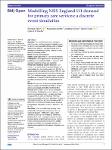Modelling NHS England 111 demand for primary care services: a discrete event simulation
| dc.contributor.author | Pilbery, R | |
| dc.contributor.author | Smith, M | |
| dc.contributor.author | Green, J | |
| dc.contributor.author | Chalk, D | |
| dc.contributor.author | O'Keeffe, CA | |
| dc.date.accessioned | 2023-10-02T19:14:18Z | |
| dc.date.available | 2023-10-02T19:14:18Z | |
| dc.date.issued | 2023-09 | |
| dc.identifier.issn | 2044-6055 | |
| dc.identifier.issn | 2044-6055 | |
| dc.identifier.other | e076203 | |
| dc.identifier.uri | https://pearl.plymouth.ac.uk/handle/10026.1/21350 | |
| dc.description.abstract |
ObjectivesThis feasibility study aimed to model in silico the current healthcare system for patients triaged to a primary care disposition following a call to National Health Service (NHS) 111 and determine the effect of reconfiguring the healthcare system to ensure a timely primary care service contact.DesignDiscrete event simulation.SettingSingle English NHS 111 call centre in Yorkshire.ParticipantsCallers registered with a Bradford general practitioner who contacted the NHS 111 service in 2021 and were triaged to a primary care disposition.Primary and secondary outcome measuresFace validity of conceptual model. Comparison between real and simulated data for quarterly counts (and 95% CIs) for patient contact with emergency ambulance (999), 111, and primary and secondary care services. Mean difference and 95% CIs in healthcare system usage between simulations and difference in mean proportion of avoidable admissions for callers who presented to an emergency department (ED).ResultsThe simulation of the current system estimated that there would be 39 283 (95% CI 39 237 to 39 328) primary care contacts, 2042 (95% CI 2032 to 2051) 999 calls and 1120 (95% CI 1114 to 1127) avoidable ED attendances. Modifying the model to ensure a timely primary care response resulted in a mean percentage increase of 196.1% (95% CI 192.2% to 199.9%) in primary care contacts, and a mean percentage decrease of 78.0% (95% CI 69.8% to 86.2%) in 999 calls and 88.1% (95% CI 81.7% to 94.5%) in ED attendances. Avoidable ED attendances reduced by a mean of −26 (95% CI −35 to −17).ConclusionIn this simulated study, ensuring timely contact with a primary care service would lead to a significant reduction in 999 and 111 calls, and ED attendances (although not avoidable ED attendance). However, this is likely to be impractical given the need to almost double current primary care service provision. Further economic and qualitative research is needed to determine whether this intervention would be cost-effective and acceptable to both patients and primary care clinicians. | |
| dc.format.extent | e076203-e076203 | |
| dc.format.medium | Electronic | |
| dc.language | en | |
| dc.publisher | BMJ | |
| dc.subject | Primary Care | |
| dc.subject | Telemedicine | |
| dc.subject | Health informatics | |
| dc.title | Modelling NHS England 111 demand for primary care services: a discrete event simulation | |
| dc.type | journal-article | |
| dc.type | Article | |
| plymouth.author-url | https://www.ncbi.nlm.nih.gov/pubmed/37673448 | |
| plymouth.issue | 9 | |
| plymouth.volume | 13 | |
| plymouth.publication-status | Published | |
| plymouth.journal | BMJ Open | |
| dc.identifier.doi | 10.1136/bmjopen-2023-076203 | |
| plymouth.organisational-group | |Plymouth | |
| plymouth.organisational-group | |Plymouth|Research Groups | |
| plymouth.organisational-group | |Plymouth|Faculty of Health | |
| plymouth.organisational-group | |Plymouth|Faculty of Health|School of Health Professions | |
| plymouth.organisational-group | |Plymouth|Users by role | |
| plymouth.organisational-group | |Plymouth|Users by role|Academics | |
| plymouth.organisational-group | |Plymouth|Users by role|Post-Graduate Research Students | |
| plymouth.organisational-group | |Plymouth|Research Groups|Plymouth Institute of Health and Care Research (PIHR) | |
| dc.publisher.place | England | |
| dcterms.dateAccepted | 2023-08-22 | |
| dc.date.updated | 2023-10-02T19:14:05Z | |
| dc.rights.embargodate | 2023-10-4 | |
| dc.identifier.eissn | 2044-6055 | |
| dc.rights.embargoperiod | forever | |
| rioxxterms.versionofrecord | 10.1136/bmjopen-2023-076203 |


